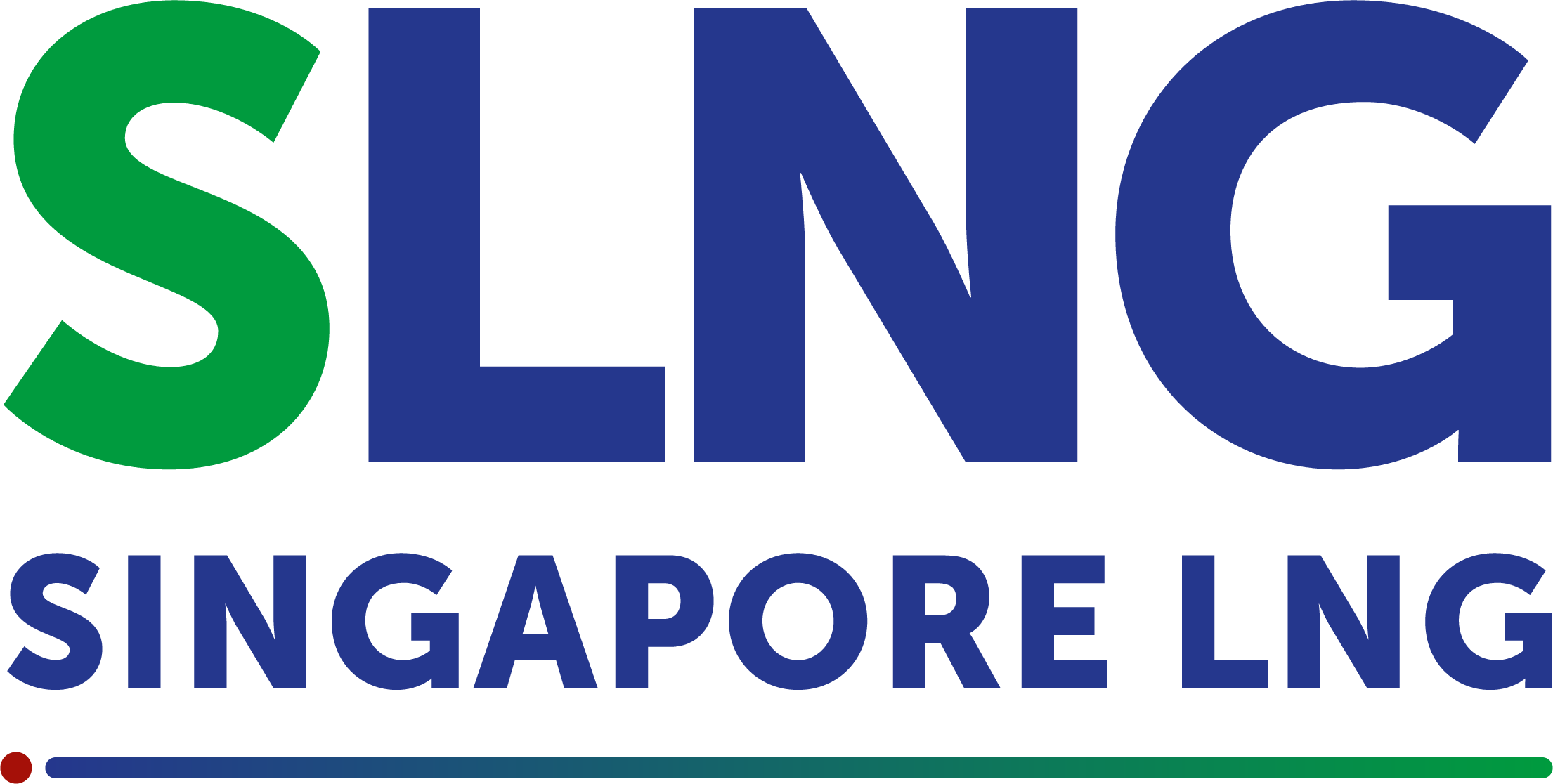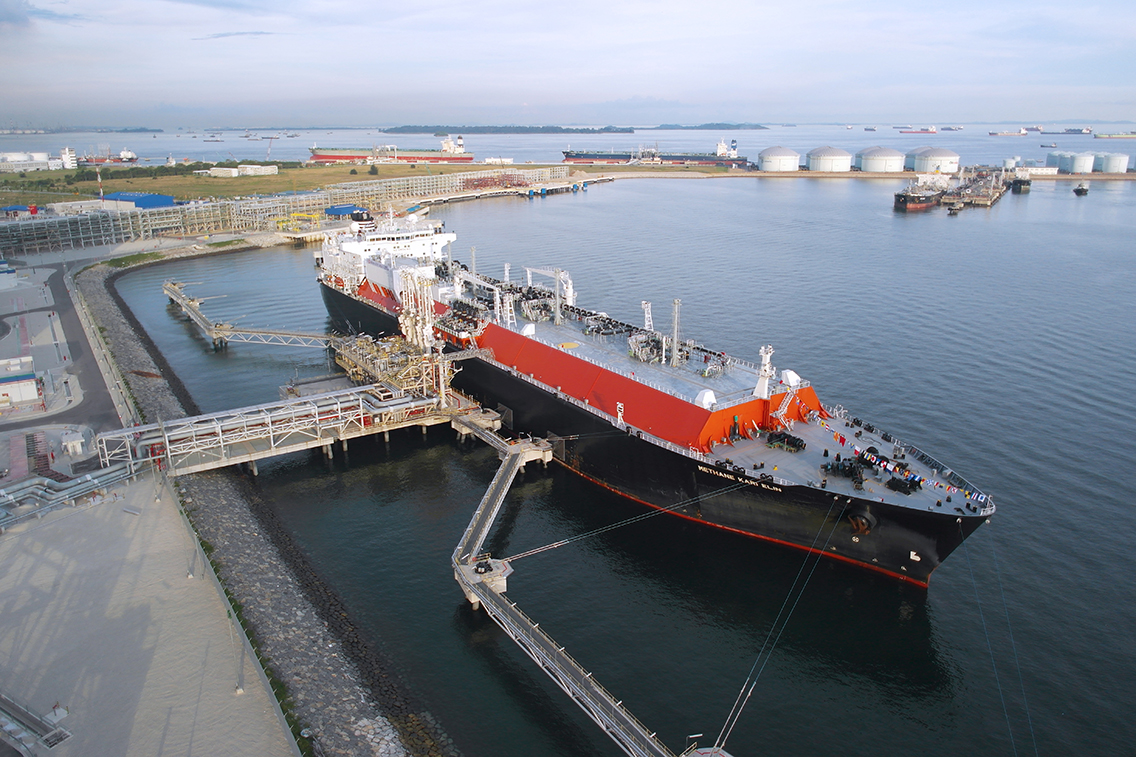Singapore's LNG Terminal Starts Commercial Operations
Singapore LNG Corporation Pte Ltd (SLNG) has procured Singapore’s first LNG (Liquefied Natural Gas) shipment from Qatargas Operating Company Limited (Qatargas), the largest LNG producer in the world.
Singapore’s energy sector marks a significant milestone today, as its Liquefied Natural Gas (LNG) terminal receives its first commercial cargo and commences commercial operations.
The LNG Terminal is a key infrastructure that supports Singapore’s energy diversification strategy. It allows the nation to import natural gas from around the world, thus enhancing its energy security and meeting future energy demand. The decision to build the Terminal on Jurong Island was made in 2006. Construction of the S$1.7b terminal began in 2010, and the first two tanks with regasification facilities are now completed on schedule and within budget. The Terminal will enable Singapore to access competitively priced gas globally, bringing benefits to consumers and unlocking opportunities for businesses.
After witnessing the arrival of the first commercial cargo at the Terminal, Mr S Iswaran, Minister in the Prime Minister’s Office and Second Minister for Home Affairs and Trade & Industry, said, “Energy diversification is an important part of Singapore’s strategy for energy security and resilience. The LNG terminal is a key infrastructure to achieve this objective. It will also contribute to the development of Singapore as a regional gas hub, catalyse LNG-related business opportunities and create new job opportunities for Singaporeans.”
Mr Neil McGregor, Chief Executive of Singapore LNG Corporation Pte Ltd (SLNG), the LNG Terminal operator, said, “SLNG is proud to have been able to deliver to its commitment on this nationally significant project. I would like to take this opportunity to thank Samsung C&T, who has been a wonderful partner. Not only were we able to complete this mega-infrastructure on time to start operations as planned, we did it while maintaining a world-class safety record, having achieved some 14 million man-hours of work on site without any lost-time injury. We look forward to serving our customers and the nation in time to come as Singapore grows to become a gas hub for the region.”
The LNG terminal will have an initial throughput capacity of 3.5 million tonnes per annum (Mtpa) with two tanks. This capacity will increase to 6 Mtpa by the end of 2013 when the third tank, additional jetties and regasification facilities are completed. Plans were announced in October 2012 for a fourth tank and associated regasification facilities to be added to the terminal, to raise its throughput capacity to 9 Mtpa.
Upcoming consultation for future LNG import framework
The LNG cargo was delivered by BG Group, which was awarded an LNG importer’s licence to import and sell up to 3 Mtpa of LNG. So far, BG has sold about 2.7 Mtpa of LNG.
The Energy Market Authority of Singapore (EMA) has concluded the first round of industry consultation on the post-3 Mtpa LNG import framework. Taking into consideration the industry feedback, EMA will launch a second round of consultation later this month.
End of Release
About Ministry of Trade and Industry (MTI)
The Ministry of Trade and Industry seeks to promote economic growth and create jobs through the development of industry sectors and international trade interests. Our strategies are derived from Singapore’s general philosophy of economic management: strong adherence to a free market economic system and active pursuit of outward-oriented economic policies. For more information on the ministry, please visit www.mti.gov.sg.
About the Energy Market Authority (EMA)
The Energy Market Authority (EMA) is a statutory board under the Ministry of Trade and Industry. Our main goals are to ensure a reliable and secure energy supply, promote effective competition in the energy market, and develop a dynamic energy sector in Singapore. Through our work, we seek to forge a progressive energy landscape for sustained growth. Please visit our website www.ema.gov.sg for more information.
About Singapore LNG Corporation Pte Ltd
Singapore LNG Corporation Pte Ltd (SLNG) was incorporated by the Energy Market Authority in June 2009 to develop, build, own and operate Singapore’s first LNG (Liquefied Natural Gas) Terminal on Jurong Island. Upon commencing commercial operations, SLNG’s core business will include LNG terminalling, storage, throughput, reloading and vessel cool down services. Beyond these, SLNG will continuously explore new LNG business opportunities as it pursues its vision to become the Gateway for LNG in Asia, and establish Singapore as the LNG Hub for the region. For more information, please visit www.slng.com.sg
For media queries, please contact:
Ms Nafisah Ismail
Senior Assistant Director, Corporate Communications
Ministry of Trade and Industry
Email: nafisah_ismail@mti.gov.sg
Mobile: 9771 9207
Ms Sharon Tan
Senior Manager, Corporate Communications
Energy Market Authority
Email: sharon_tan@ema.gov.sg
Mobile: 9185 7882
Mr Simon Ang
Manager, Corporate Communications
Singapore LNG Corporation Pte Ltd
Email: SimonAng@SLNGCorp.com
Mobile: 9664 6161
Annex A
Interesting Facts and Figures about Singapore’s LNG Terminal
Terminal’s Key Specifications
- Current plans for the LNG terminal include three storage tanks, three jetties, and a throughput capacity of up to 6 million tonnes per annum (Mtpa).
- Plans for a fourth storage tank and associated regasification equipment have been announced. This will raise the terminal’s throughput capacity to 9 Mtpa.
LNG Tanks
- The first three LNG tanks are each 53 metres high and 90 metres wide. Each of these tanks can hold 180,000 cubic metres of LNG, large enough to fit three Boeing 747 aircraft stacked on top of one another within it.
- A total of 27,832 cubic meters of concrete, 5,032 tons of steel reinforcement bars and 3,681 tonnes of steel plate was used for each tank.
- There are 562 steel piles for each tank’s foundation. Each tank sits on an area of 6,358 square metres. This is equivalent to 14 basketball courts.
- Two additional layers of nickel steel plate and carbon steel plate line the inside of the one-metre thick concrete walls of each LNG tank.
- The roofs of tanks 1 and 2, each weighing 1,200 tonnes, were first built at ground level and then raised 53 metres high using compressed air. At a speed of about 200mm/minute, the raising of each roof took around four hours.
Pipes
- There is a total of 1,555 tonnes of piping in the pipe racks at the LNG terminal. When laid out straight, it is equivalent to the distance from Singapore to Malacca.
Throughput Capacity (Regasification)
- Regasification is the act of warming LNG from its liquid state to its gaseous state.
- The LNG terminal has an initial regasification capacity of 3.5 Mtpa of LNG. This will increase to 6 Mtpa when the third tank, additional jetties and regasification facilities are completed by the end of 2013. Plans were announced in October 2012 for further regasification facilities to be added to increase the throughput capacity to 9 Mtpa.
Safety Track Record
- To date, more than 14 million man-hours were worked on the LNG terminal project with zero lost-time injury. At its peak, there were 2,900 people working at the LNG terminal construction site.
Annex B
Background of LNG in Singapore – Chronology of Events
On 7 August 2006, Mr Lim Hng Kiang, Minister for Trade and Industry announced that Singapore would build an LNG terminal to import LNG to diversify its sources of energy and to meet Singapore's rising future demand for energy.
On 4 September 2007, Mr S. Iswaran, then Minister of State for Trade and Industry, announced that the Energy Market Authority (EMA) would call a Request for Proposal (RFP) for interested parties to participate in the selection process as an LNG Aggregator. Interested parties were invited by EMA to submit their business concepts for the Aggregator role. PowerGas Ltd (PowerGas), a wholly-owned subsidiary of Singapore Power Limited, was then designated as the LNG terminal owner and operator.
On 18 April 2008, BG Singapore Gas Marketing Pte Ltd was appointed as the LNG Aggregator for Singapore. In this role, BG would aggregate demand for regasified LNG from all end-users in Singapore and procure LNG supply for up to three million tonnes per annum (Mtpa).
On 28 April 2008, PowerGas was appointed as the developer of the LNG terminal.
On 30 June 2009, Mr S Iswaran, then Senior Minister of State for Trade & Industry and Education announced that the Government would take over the development and ownership of the Singapore LNG terminal, as it was difficult to proceed with the project on a commercial basis. EMA subsequently formed a new company, Singapore LNG Corporation Pte Ltd (SLNG), to own the terminal and oversee its development.
On 8 February 2010, SLNG awarded the contract for the engineering, procurement and construction (EPC) of Singapore's LNG terminal to Samsung C&T Corporation (Samsung). Foster Wheeler Asia Pacific Pte Ltd (Foster Wheeler) was also appointed by SLNG as Project Management Consultant.
On 31 March 2010, a groundbreaking ceremony was held at Jurong Island for Singapore’s LNG terminal. Mr S Iswaran, then Senior Minister of State for Trade & Industry and Education announced that six generation companies have committed to an initial tranche of around 1.5 Mtpa of regasified LNG. The six companies – Senoko Energy, PowerSeraya, Tuas Power Generation, SembCorp Cogen, Keppel Merlimau Cogen and Island Power Company (now PacificLight Power) – entered into long-term gas purchase contracts with BG Singapore Gas Marketing Pte Ltd.
On 2 November 2010, Mr S Iswaran, then Senior Minister of State for Trade & Industry and Education announced the decision to proceed with the construction of a third LNG storage tank at the terminal. He also announced that the six generation companies have made firm commitments to purchase an increased volume of 2 Mtpa of regasified LNG.
On 21 January 2011, SLNG announced the award of the contract for the EPC of the third LNG storage tank to Samsung. The third 180,000 cubic metre LNG tank, in addition to the two similar-sized tanks that were being built, would increase the terminal’s storage capacity to handle up to 6 Mtpa of throughput. This addition gives Singapore greater flexibility not just to meet its future gas needs, but also to pursue new business opportunities in the LNG market.
On 4 August 2011, SLNG announced the award of the EPC contract for the Secondary Berth Project to Samsung. The project, which forms part of the S$1.7 billion overall Singapore LNG terminal project cost, comprises a secondary jetty designed to berth LNG ships with a cargo capacity ranging from 60,000 to 265,000 cubic metres (m3), and a tertiary jetty marine sub-structure designed for the future berthing of smaller LNG ships and barges with cargo capacity ranging from 10,000 m3 to 40,000 m3. The Secondary Berth Project will give added flexibility and value to the range of LNG terminal services that SLNG can offer its customers in Singapore and regionally.
On 24 October 2012, Mr S Iswaran, Minister in Prime Minister’s Office and Second Minister for Home Affairs & Trade and Industry, announced the plan to build a fourth LNG tank and associated facilities to boost the capacity of the LNG terminal to about 9 Mtpa. This is to ensure that the infrastructure can cater to Singapore’s future energy needs.
On 29 October 2012, the Front End Engineering Design (FEED) project to define the scope of the expansion of the LNG Terminal’s send-out and storage capacities, kicked off. The expansion plans include the installation of additional facilities to increase the Terminal’s capacity to 9 million tonnes per annum (Mtpa), and the construction of a fourth tank.
On 27 March 2013, the first commissioning LNG cargo was received at the Singapore LNG Terminal. The commissioning cargo was procured from Qatargas and delivered by the Umm Slal, which is a Q-Max LNG vessel - currently the largest LNG vessel in the world. The LNG cargo was used to cool down and commission the LNG Terminal, to get it ready for full and continuous operations.
On 7 May 2013, the LNG terminal received its first commercial cargo, hence marking the terminal’s commencement of commercial operations.
Download Full Press Release Here (249.83 KB)

